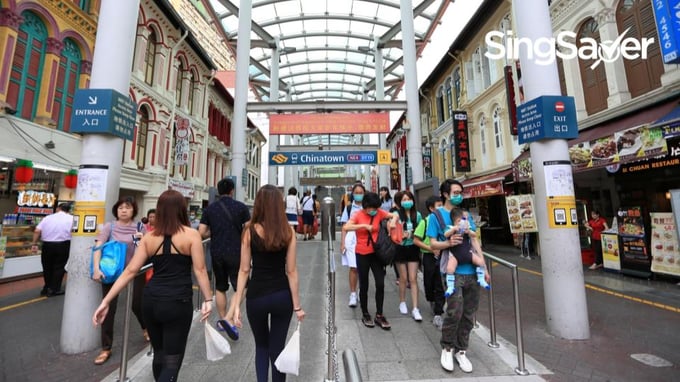Update as of December 14: It's official — Phase 3 is slated to begin on December 28. And here’s what we know so far, keeping you clued in.
It’s been some time since Phase 2 started on 19 June, and Phase 3 will officially be here in two weeks' time. This was recently confirmed by Prime Minister Lee Hsien Loong, who announced that social gatherings of up to eight people will be allowed in public, up from five currently. Similarly, households can receive up to eight visitors. If you're looking for last-minute activity ideas for your group of eight, here's a curated list just for you.
Note: COVID-19 measures and updates are frequently being revised. We request you to stay tuned to gov.sg and verify all information.
We had earlier reported (see below) about what Phase 3 would bring for us. If you needed a ready reckoner of what has transpired so far, here's a recap for you.
What to expect in Phase 3 in Singapore
On October 5, DPM Heng Swee Keat outlined a four-pronged strategy for Singapore’s safe reopening in the coming weeks, comprising:
- Securing early access to effective vaccines
- Enhancing testing capabilities
- Conducting swift contact tracing and isolation of infected individuals
- Adhering to safe management measures
This is largely in line with an earlier update.
Phase 3 will, undoubtedly, be Singapore’s ‘new normal’ in a lot of ways and will guide our way of life until a vaccine or an effective treatment for COVID-19 becomes widely available. Here are some changes we can look forward to in Phase 3, based on updates released so far.
Increase in maximum group size
The current limit of 5 persons per group may be increased, allowing larger families and bigger groups of friends to meet and have meals together. As of the latest update, authorities are mulling raising the maximum group size from 5 to 8 people; this would apply to social gatherings outside as well as home visitors.
However, the lifting of this restriction requires the following three conditions:
- The continued adherence to safe management measures, including safe distances, small group sizes, and exercising social responsibility.
- Larger scale testing, including a pilot scheme that would see people tested before attending events. This would involve the use of rapid tests with less accuracy (such as this nifty breath-test, perhaps?)
- The use of TraceTogether tokens or apps to check in to SafeEntry (instead of scanning QR codes). In preparation for Phase 3, TraceTogether check-ins will be required for entry into all popular venues, including restaurants, cinemas, workplaces, schools and shopping malls.
Expansion of business and official travel arrangements
If the current business travel pass programme presents favourable outcomes, we are likely to see an extension to include more employees. This will help companies with international footprints resume essential business activities such as sales calls and training.
The number of bilateral green lanes meant to facilitate business and official travel will also likely increase. Current reciprocal green lanes include ones with China, Malaysia, Korea, Japan and Indonesia.
Increase in air travel bubbles
A step towards opening up leisure air travel again, Singapore will likely continue to seek more travel bubble agreements with different countries and cities, similar to the one finalised with Hong Kong. Such agreements allow leisure travellers to avoid serving quarantines, provided they pass a COVID-19 screening. This will help stimulate the leisure travel sector in Singapore.
As more destinations open up their borders to Singapore, you will want to block your calendar. As you gear up to get on a plane (hopefully soon), take stock of the evolving COVID-19 circumstances and apply for travel insurance to protect yourself while you’re on holiday.
Standing invitations to travellers from more countries
In addition, the Government is likely to open Singapore’s borders to more countries who manage to bring the virus under control. Currently, countries with such standing invitations include Brunei, New Zealand, Vietnam and Australia (excluding Victoria state). Adding more countries to the list will help to encourage growth in inbound tourism receipts.
Allowing insurance and subsidies for COVID-19 treatment for travellers
In line with the overall push to gradually re-open Singapore’s borders, citizens, permanent residents and long-term pass holders who travelled outside of Singapore from March 27 will, once again, be able to tap on government subsidies and insurance coverage to help pay for their COVID-19 bills.
This was a reversal from the previous policy wherein travellers who went overseas after 27 March, despite advisories, would have to finance their own COVID-19 treatments. Notwithstanding this, non-essential travel, especially to high-risk countries, should continue to be avoided for the moment.
However, from 1 Jan 2021, all incoming Singaporeans, PRs and Long-term Pass Holders will have to pay for their own stay at dedicated stay-home facilities, if found to be infected within 14 days of arrival.
New, less invasive tests with quicker results
Part of a successful reopening strategy is fast and accurate resting. Although Singapore is, currently, able to conduct nearly 40,000 polymerase chain reaction tests per day, the authorities are continually seeking higher testing standards. This could see the development and/or adoption of newer testing methods that are less invasive and are able to produce results quicker.
One such innovation is the new COVID-19 breath test developed by NUS, which only requires a candidate to blow into a disposable mouthpiece. During a clinical trial involving 180 participants, the device was found to be capable of detecting volatile organic compounds in a person’s breath with more than 90% accuracy.
All of these changes notwithstanding, some measures and restrictions will continue to dictate our movements.
Measures and restrictions implemented so far
The reality is that COVID-19 has wrought sweeping changes in almost every aspect of our everyday lives. Here’s taking a look at a summarised list of some of the most important changes instituted since the lifting of the Circuit Breaker in June.
Stay-home-notice
Incoming travellers and Singaporeans have to serve a mandatory stay-home-notice (SHN) lasting up to 14 days, either at their own residences or at dedicated facilities. Depending on their travel itinerary as well as their residency status, they may have to pay for COVID-19 swab tests, stays at dedicated facilities, and unsubsidised inpatient hospital stays if found to be infected.
A COVID-19 test can cost up to $200, while it costs $2,000 for a 14-day stay at a hotel earmarked for SHN purposes.
Wearing of masks
Masks must be worn at all times when in public, including in the office. Masks may be temporarily removed when exercising, eating, drinking or smoking. Children under age 6 don’t need to wear masks, but face shields should be worn as much as possible.
Contact tracing
Entry and visits to public places and amenities require Safe Entry check-in or identification card scanning in order to facilitate contact racing in case of infections.
Safe distancing and restricted group size
Group sizes for social gatherings are limited to a maximum of 5, even if they are members of the same household. Groups larger than 5 must observe a safety distance of at least 1m between groups, and members must not intermingle (such as when visiting a restaurant, cinema or shopping mall). Within the home, up to 5 visitors are allowed to be received at any one time.
On 4 August, the count of 20 people was increased up to 30 at funerals and wakes. And from 3 October, up to 100 individuals are allowed for wedding solemnisation and receptions.
Similarly, all religious organisations will be allowed to conduct congregational and other worship services for up to 100 people. All the above are subject to safe distance and safe management measures.
Restricted capacity for various venues
The need for safe distancing also saw operational capacity being limited at various venues, such as
- Cinemas: Up to 150 patrons separated into zones of not more than 50 patrons each
- Gyms and fitness studios: 1 person per 10 sqm, capped at a maximum of 50 people at any one time. Maximum of 5 people in any one group with safe distance of 2m (3m for strenuous activities) to be observed.
- Eateries: Tables to be spaced 1m apart and diners are limited to 5 per group. Self-service buffet lines and common amenities such as drinks dispensers are disallowed.
- Entertainment venues: Bars, clubs and concert halls as well as other venues that attract large crowds and encourage mingling are not allowed.
Limited activity in offices
While work-from-home (WFH) remains the default, employers may arrange for employees to return to the office subject to the following conditions:
- Such employees continue to WFH for at least half their working time
- No more than half of such employees are at the workplace at any point in time
Workplace events and activities taking place within the office, such as seminars, conferences and retreats are allowed for up to 50 persons. However, employers are also reminded to adhere to safe distance and other measures. They must also continue to observe split teams or shift arrangements. To help ease peak hour congestion, employers are encouraged to stagger reporting times.
Working from home? Then you’ll want to swipe your utility bills on the correct credit card to earn points, air miles and cashback that can go into funding your next shopping adventure or staycation. Apply for one with us today and get rewarded with cash or prizes*!
Read these next:
The Real Cost Of Working From Home (WFH) May Surprise You
Will My Travel Insurance Cover Novel Coronavirus (COVID-19)?
How Much Do Health Screenings In Singapore Cost?
If I Get COVID-19, What Will I Need To Pay?
Green Lanes, Travel Bubbles, Air Bridges From Singapore: Where Can I Go Now?
Similar articles
Phase 3 (Heightened Alert): Your Guide To Important Numbers And Safe Distancing Rules
Phase 2 Returns: How Will This Affect Flights, Staycations & Cruises?
Liquor Lovers, Here Are 3 Ways You Can Invest In Rare Whisky
Singapore Relaxes SHN Requirements And Eases Border Restrictions: All You Need To Know
Phase 2 Post-Circuit Breaker: What Reopens And What’s Allowed
Full Details: Taiwan Plans Tourism Reopening from October
Cruise To Nowhere: Is It Worth Your Money And Time?
Social Gatherings Increased To Groups Of 10, Mask-Wearing Outdoors Optional From 29 March 2022 Onwards










